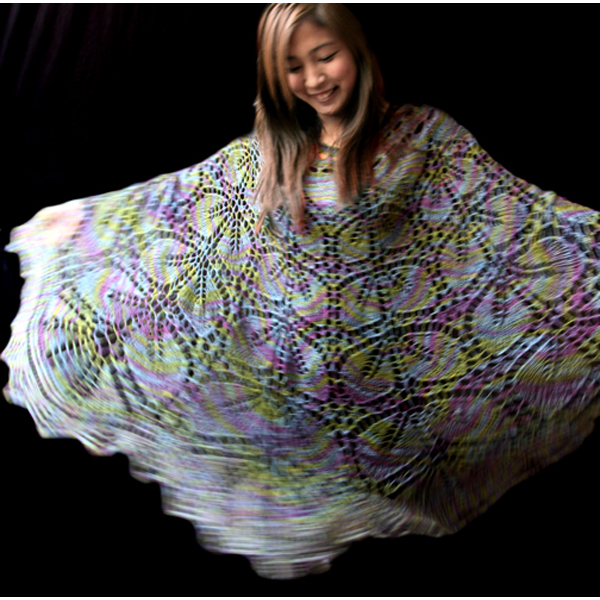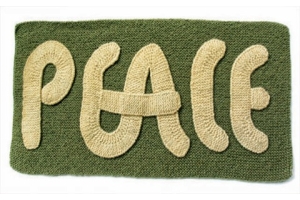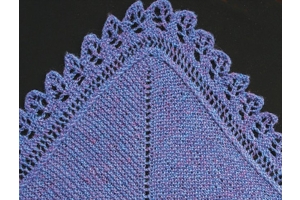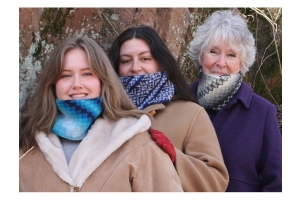Blog #35 Meg Swansen interviews author Jeannine Bakriges


Dear Knitter,
A book about spinning, dyeing, and knitting may seem a bit daunting. However, although only one of the three disciplines, spinning, dyeing, or knitting, may interest you at present, you will find it thoroughly discussed in this intriguing book. The other two topics will await in case you wish to turn to them in future.
But for Fiber People, each of the three topics easily may become a passion in its turn. Even though I have never been a dyer, I read that section with great interest (not unlike all the cookbooks that I read as literature, but have never specifically followed).
Through a series of questions I posed to her recently, I was able to probe the mind of author, Jeannine Bakriges:
Q: You are an expert in all three disciplines: spinning, dyeing, knitting. In what sequence did you begin your journey?
A: I began my fiber arts journey with knitting. I did a tad of knitting as a kid, being taught by girlfriends in the neighborhood. We grew up in Detroit, Michigan, where our yarn came from Kresge’s Five and Dime. I was mesmerized by all the colors of the available yarn. In the late 1970s, books by Elizabeth Zimmermann, “Knitting Without Tears,” and "Knitter's Almanac," beckoned loudly to me when I was at the local library. I had finished my undergrad degree in Art Education, and a light bulb went off after reading a few pages of those books that THIS was something I could sink my teeth into. I even thought to myself (no joke), “If I live to be a relatively old age (I was in my early 20’s at the time), I could have the grand fun of learning lots of what EZ spoke of." BTW, I was inspired to write because of Elizabeth’s work, and her stories in “Knitter’s Almanac,” remain especially near and dear.
Next on to spinning. I took a disastrous class at a museum in Dearborn, Michigan around the same time I began knitting. The instructor taught us, standing up, with spindles that I later called “head bonkers” – heavy pieces of wood that would have worked better as garden fence posts than yarn spinning implements. My spindle kept crashing to the floor. A few times of this happening found me sheepishly sneaking out, never to return to the class. It wasn’t until we moved to Bennington, Vermont that a lovely woman, who was a weaver and raised Cheviot sheep, taught me to spin on a Louet S10 wheel. I ended up buying that same wheel for myself from WEBS (when they were located on Kellogg Street in Amherst, Massachusetts), and still love it.
Interest in natural dyeing was spurred on by an early 1980s article in Spin-Off magazine, featuring a spent Christmas tree to be used for dye material. I was smitten.
 Q: What was your very first dyeing project? And what equipment did you acquire to begin with? Can you suggest the bare minimum of tools for someone to experiment dyeing a commercially purchased skein of wool?
Q: What was your very first dyeing project? And what equipment did you acquire to begin with? Can you suggest the bare minimum of tools for someone to experiment dyeing a commercially purchased skein of wool?
A: My main interest in dyeing was to use "natural" dyes, mostly fresh or dried plants, but woods, etc. came soon after. I nearly always dyed my own handspun yarn rather than commercial yarn. I remember dyeing small handspun samples with goldenrod, black walnut hulls, and more. I studied plant identification books as if they were the latest, greatest novels. Some of those early samples were used in color-patterned socks, such as "Naturally Dyed Funky Faroese Socks," featured in the Summer 2003 issue of Spin-Off Magazine.
A discussion of bare minimum equipment for dyeing has to begin first by saying never to use pots or utensils you cook with for dyeing. A canning kettle that's enamel or stainless steel with a lid is nice, but there's no reason you can't start with a smaller pot. A largish slotted spoon is helpful, as are wood spoons. A candy thermometer can keep you in the ballpark of the degree of heat needed. Good ventilation is a must. I love to dye outside, but if that's not possible weatherwise, a hotplate can be used in a well ventilated area (avoid the kitchen, please). Have a looksee at the solar dyeing information in my book, for it's very gratifying not having to "plug in" or burn fossil fuels or wood in order to dye. And if you're going to dye with plants or other natural dyes, there's no substitute for a commitment and follow-through regarding ongoing reading and research, either via books, videos, or other online websites/blogs. By educating yourself on safe dye practices and useful techniques, including safe mordant use (if you're natural dyeing), masks, gloves, aprons, etc. you'll protect yourself and others. A great place to get needed items for natural and/or chemical dyeing continues to be Dharma Trading Company: https://www.dharmatrading.com/ You'll find dyeable yarn, fabric, finished clothing, and all sorts of dyes, natural and chemical, and helpful equipment to consider.
Q: Do you recommend using dye-plants, or purchased dye-packets for beginners?
A: I personally love working with dye plants, be they fresh or dried. A favorite memory is walking through fields of wildflowers, black walnut trees, and other interesting plants with a violin teacher of our oldest son at the time, her being an enthusiastic and knowledgable natural dyer, pointing out plants that she thought would be helpful for me to learn about. But there's nothing wrong with using powdered or liquified dyes, be they natural, as in dye extracts, or of the chemical type. In addition to Dharma Trading Company, mentioned above, Etsy is a great online platform where you'll find indie shops and more that offer dyes, yarns, fibers, books, etc.

Q: Dye sources may have changed in recent years. Can you recommend a few good suppliers for new and experienced dyers?
A: It is important to realize dye sources have, indeed, changed in recent years. If you're looking at the classifieds of old Spin-Off magazines, you may be disappointed to find the shops who sold what you're looking for are no longer around. Best to do a current internet search, and/or if you're lucky enough to be near fiber arts shops that offer in-person browsing, have grand fun with all the eye-candy they offer. In addition to the recommendations I've posted above, you can always get/subscribe to magazines that are still publishing new issues, such as Spin-Off, or Handwoven, or others that feature ads of often long-time, well-known shops that include dyeing products. The Woolery, Mielke's Fiber Arts, The Yarn Barn, Halcyon Yarn, and more come to mind. You'll find knowledgable, kind people who can help you at any of these places and more.
Q: Is there a specific sheep breed who’s fleece you particularly love to spin?
A: I love Romney fleece. It's lustrous, dyes beautifully, scours wonderfully, and can be found in a range of hands from soft to strong. It's so versatile!
Q: What governed your decisions when choosing knitting designs of Elizabeth's and Meg’s for Spinning Around?
A: Really, any of Elizabeth's or Meg's designs would have worked splendidly for the book. When I realized I needed to install the help of spinning/knitting friends if the book was ever going to get completed, I compromised what designs I had originally envisioned when they chose a design that they, personally, wanted to work on.

Q: Do you spin randomly, then choose a garment to knit? Or does a chosen knitting design dictate your spinning and dyeing?
A: For the book, I chose the garment to knit, and spun and dyed to what I felt would showcase that design. These days, however, due to recently being gifted a small 26", 8 shaft loom that belonged to a friend's mother, I'm spinning to sew garments from my handspun and handwoven fabric. I'll use my Ma's 1960's Singer Touch and Sew for the sewing. I've become very excited upon discovering the work of Sarah Howard, of "Get Weaving," (on Etsy) from Clacton-on-Sea, UK. Sarah focuses on creating sewn patterns using narrow width handwoven cloth, for us folks who don't have big looms. I haven't been this excited since I first discovered Elizabeth's work all those years ago. So to answer your question, I'm presently spinning yarns from fibers that make my heart sing - some plain, some glitzy, some colorful, some textured - and will put those yarns together for warp and weft in whatever ways please me. In other words, I'm free to spin anything I want and don't have to have a set plan up front. It's very freeing.
Q: Once decisions have been made, do you spin sufficient yarn for the entire project? Or do you spin a few ounces - then knit - then spin some more and knit some more, so you will come out evenly in the end?
A: When I was working on the book, I usually spun sufficient yarn for the entire project once I knew what I was spinning for. But this wasn't a hard and fast rule, and no doubt odds and ends made their way into my knitted projects in general.
Q: Your book is quite unique in its inclusion of three substantial topics. As you began to assemble information for Spinning Around, what influenced your decision to include all three disciplines into one book?
A: It was just a natural decision to include all that I was enthusiastic about. If what I shared revved the creative engines of those who came upon the book, that was a surefire recipe for happiness for all concerned. I like to share the wealth in all that I do.
Q: If someone was looking to start to spin some of their own yarn, do you advise a particular method (drop-spindle or wheel), and do you have advice on where to search for raw fiber?
A: Everyone learns differently, imho, so some will gravitate to learn spindle spinning first and others will want to hop right on a wheel to first learn to spin. Either way works wonderfully, and one isn't really better than the other. What matters is that the person who wants to spin is excited to do so, and is willing to dive in online and/or via classes/videos/one-on-one instruction, and/or through books/magazines. I, personally, like to purchase raw fleece and other prepared fibers and dyes from sheep and wool fests. In the fall I love going to the NY Sheep and Wool Fest (fondly called Rhinebeck by many) or the New England Fiber Festival. In the spring my choices include the Massachusett's Sheep and Woolcraft Fair (fondly called Cummington by many) or the New Hampshire Sheep and Wool Fest. Those are festivals within driving distance from me. Doing an online search will provide fests that are near to the seeker. Joining a spinning or fiber arts guild is a fun way to learn from other enthusiasts about where to buy what. All it takes is an online search to find groups or guilds near to you, and/or who are meeting on Zoom.
Thank you, Jeannine Bakriges! What a lovely conversation.
Meg
And one of Jeannine’s designs (from her book, of course) is now on our home page. Isn’t that a lovely photograph?





